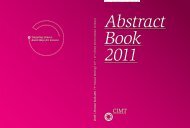Abstract Book 2010 - CIMT Annual Meeting
Abstract Book 2010 - CIMT Annual Meeting
Abstract Book 2010 - CIMT Annual Meeting
You also want an ePaper? Increase the reach of your titles
YUMPU automatically turns print PDFs into web optimized ePapers that Google loves.
116 Hotz | Enhancing immunity & adjuvants<br />
A rational protocol of repeated TLR7 stimulation<br />
circumvents induction of TLR tolerance and translates<br />
into efficient anti-tumor therapy<br />
Christian Hotz 1 , Andreas Völkl 1 , Daniel Noerenberg 1 , Nadja Sandholzer 1 , Cornelia Wurzenberger<br />
1 , David Anz 1 , Stefan Endres 1 and Carole Bourquin 1<br />
1 Center for Integrated Protein Science Munich, Division of Clinical Pharmacology,<br />
Department of Internal Medicine, Ludwig-Maximilian University of Munich, Munich, Germany.<br />
166<br />
Topical application of small molecule toll-like re-<br />
ceptor 7 (TLR7) agonists is often highly effective<br />
for the treatment of skin tumors, whereas their systemic<br />
application has been largely unsuccessful<br />
for the immunotherapy of cancer. One reason may<br />
be that repeated application of certain TLR ligands<br />
can induce a state of immune unresponsiveness,<br />
termed TLR tolerance. We show here that a single<br />
injection of the TLR7 agonist R848 in mice induces<br />
a short period of increased responsiveness followed<br />
by a state of hyporesponsiveness lasting several<br />
days. We demonstrate for the first time that TLR7<br />
tolerance occurs in plasmacytoid and myeloid dendritic<br />
cells, that play a critical role in the initiation<br />
and amplification of antitumor immune responses,<br />
and results in inhibited secretion of the key cytokines<br />
IFN-κ, IL-12p70 and IL-6 both in vitro and in<br />
vivo. We further show that TLR7 tolerance in plasmacytoid<br />
dendritic cells is accompanied by downregulation<br />
of the adaptor protein interleukin-1 receptor-associated<br />
kinase (IRAK-1). Based on these<br />
findings, we have designed a novel strategy for the<br />
treatment of murine CT26 tumors using cycles of<br />
repeated R848 injections separated by 5-day treatment-free<br />
intervals. We show that this protocol<br />
circumvents TLR7 tolerance and translates into<br />
efficient cancer immunotherapy whereas single injections<br />
given within shorter intervals do not.



